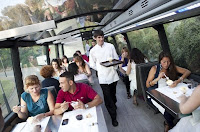Vidurglass has set a new milestone with the fabrication of curved PV glass modules on the basis of traditional production processes for laminated safety glazing elements. This offers multiple new design-possibilities for demanding architecture, urban furniture or urban lighting elements.
Traditionally, crystalline PV modules have only been available as flat panels because of the difficulties in bending a laminate leading to the fracture of the fragile PV-cells, that have a thickness of only 0,2 mm in an average. Curved or flexible PV-products have only been done with thin-film technlogiy for special products, mainly for opaque roof applications. This lead to restrictions for applications in niche markets where BIPV could play a bigger role. Now, Vidurglass has overcome these difficulties with a new production process that permits the fabrication of PV-glass modules with a radius of down to 5000mm (others radius on demand).
Apart from rather architectural applications, these modules are specially indicated for their integration in roofs of vehicles like busses and coaches, also trains or in ships and boats. Vidurglass has started a first project for the integration of PV-cells in bus roofs in order to offer an aesthetical visual effect in the interior of the bus and to generate clean energy for supporting the operation of the air conditioning system. This can lead to important fuel savings and quick payback of the initial investment, a part form permitting the bus builders and tour operators an ecologic image positioning.
As usual, these curved VIDURSOLAR PV-elements are being laminated with PVB for enhanced safety against fall in case of breakage and maximum durability. As for conventional flat PV-glass modules from Vidurglass, the compliance of the necessary construction norms and the highest quality standards is guaranteed.
Curved VIDURSOLAR PV glass modules are also available with PV cells of other colours that can be
 combined with multiple specialist glass treatments and translucent colours of PVB. The mounting can be done like traditional glass units, by a traditional structural framework or also be point-fixing units. As for more conventional PV-glass units, the electrical connection system can also be chosen by the customer, backside junction boxes or edge terminals are available.
combined with multiple specialist glass treatments and translucent colours of PVB. The mounting can be done like traditional glass units, by a traditional structural framework or also be point-fixing units. As for more conventional PV-glass units, the electrical connection system can also be chosen by the customer, backside junction boxes or edge terminals are available.With this product range, new ground-breaking architectural concepts can be created that differ completely from the image of conventional PV-modules commonly used in traditional PV projects.
This new development shows that PV-technology can play an important role regarding the integration of renewable energy into urban spaces and also mobile surfaces broadening significantly the freedom in design for architects, urban planners and vehicle designers.
New PV projects finished
A selection of new projects recently finished in the Building Integrated Photovoltaic sector.
With a total power of 106 kWp composed of 576 photovoltaic glasses laminated with PVB.
The roof is composed of PV modules and screen-printed glasses to improve the aesthetics as a whole. The power of 3,1 kWp feeds in autonomously the bar’s consumption installed in this application.
Integration of PV glasses as parapet designed as insulating glass unit. The interior glass is grey solar control type to match with the rest of the glazing units.
For more information click on the link to see the complete list http://www.vidurglass.com/en/solar/solar-projects or vidurglass@vidurglass.es




































